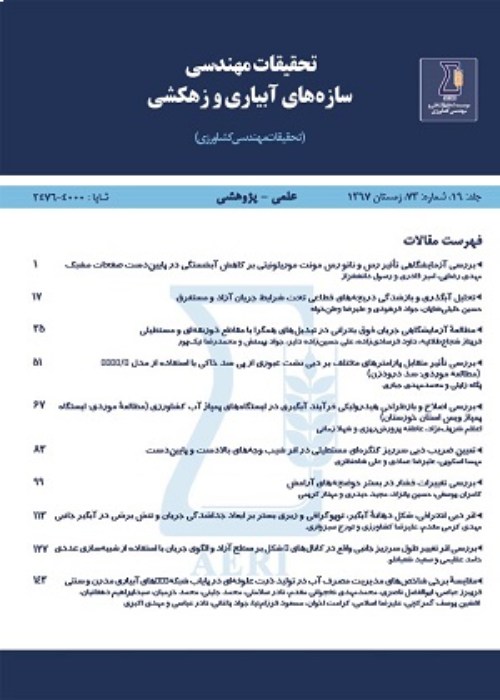Experimental investigation of the effect of the height of the trapezoidal piano key side weir on the discharge coefficient and water level profiles.
The side weirs are widely used in sewage networks to aerate streams, irrigation and drainage networks to control water levels for dewatering, rivers for coastal management, and flood management of dams. One of the newest types of weirs researchers have considered in recent years is the piano key weir. Piano key weirs have a higher efficiency than other weirs due to their special geometry, especially the presence of upstream and downstream overhangs, as well as inlet and outlet keys. The use of piano key weirs as side weirs has received less attention from researchers, and because these weirs show better performance in discharge, more and more research is needed. The main objectives of the present study are first to investigate the effect of trapezoidal piano key weir height as one of the geometric parameters affecting the discharge coefficient and second to investigate the water surface profiles at the upstream and downstream ends and within the location of the weir in the main channel. In parallel with the main objectives, the study of the Dimarchi hypothesis in estimating the discharge coefficient and the study of discharge efficiency of the trapezoidal piano key is also followed. In this regard, four models of trapezoidal piano key overflow with a height of 10, 15, 20, and 25 cm (TPKSWp10, TPKSWp15, TPKSWp20, and TPKSWp25), a labyrinth trapezoidal weir model with a height of 20 cm (TNRSW) and also rectangular sharp crest weir as The control model (Lisw) was tested under the subcritical flow with the Froude numbers in the range of 0.10 to 0.74. De Marchi, in 1934, assuming that the specific energy was constant at the upstream and downstream ends, calculated an equation for estimating the discharge coefficient of the side weirs that were related to the hydraulic parameters of the flow at both the upstream and downstream ends of the weir. In this study, the main hypothesis for estimating the piano key weirs' discharge coefficient is the Di Marchi hypothesis. The results show that, firstly, due to the specific energy changes at the upstream and downstream ends of the trapezoidal piano key models (ΔE/E1), especially in the TPKSWp10 and TPKSWp15 models, and the occurrence of hydraulic jump that affects the essence of the flow, use the Dimarchi hypothesis And comparing the discharge coefficients of trapezoidal piano key side weirs should be done with caution. The discharge capacity of the side weirs is defined as the ratio of flow spill from them to the inflow to the main channel. The results of this study show that the discharge capacity of trapezoidal piano key weirs increases with increasing height due to the more uniform water surface profile, reducing the interference of the outlet blades of the inlet and side crest and reducing the vortex in the inlet openings and faster exiting than the outlet keys. In the TPKSWp25 model, the discharge capacity is 2.60 times higher than the Lisw, and for the TPKSWp20, TPKSWp15, and TNRSW models, it is 1.92, 1.59, and 1.38 times higher than the Lisw, respectively. In the present study, two types of diagrams have been used to investigate the effect of the height of trapezoidal piano weirs on the water surface profile due to the complexity of the flow pattern and the simultaneous effect of geometric and hydraulic parameters of the weir and better analysis of these parameters on the water surface profile Also, the water level decreases in the longitudinal section Z*=1 (on the crest weirs) and at the upstream end of the weir due to the increase in the longitudinal acceleration of the flow and being affected by the suction of the flow by the weir in this range in all experimental models. This water level reduction for TPKSWp15,20,25 models and TNRSW models is almost the same and equal to 25%.
- حق عضویت دریافتی صرف حمایت از نشریات عضو و نگهداری، تکمیل و توسعه مگیران میشود.
- پرداخت حق اشتراک و دانلود مقالات اجازه بازنشر آن در سایر رسانههای چاپی و دیجیتال را به کاربر نمیدهد.



